If you have upgraded to Lightroom 4, 5, 6 or CC from Lightroom 3 or earlier (even if you came via Lightroom 4), when you look at photos in the Develop module that came from Lightroom 3, you will see a lightning bolt below the histogram if the histogram is open, or to the left of the panel name if it is closed:
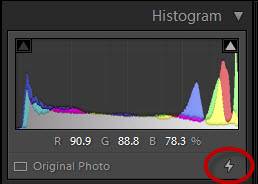

The equivalent symbol in Lightroom 4 was an exclamation point below your photo:
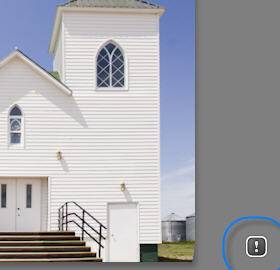
The lightning bolt is a signal to you that the photo is continuing to use your settings from the old (pre-Lightroom 4) processing technology. The photo therefore should look the same to you as it did as you had left it in the earlier version of Lightroom (worked or unworked), and you will have the same Develop controls as before (for example, Recovery and Fill Light in the Basic panel, instead of Highlights, Shadows, Whites and Blacks.)
The newer controls/technology, the same in Lightroom 4, 5, 6 and CC are called Process Version 2012; the old Lightroom 3 controls/technology are called Process Version 2010. Both the 2010 and 2012 process versions are built into Lightroom 4, 5, 6 and CC. New photos you import into Lightroom 4, 5, 6 and CC, or photos that you never worked on in Lightroom 3 automatically use Process Version 2012. Photos that you worked on in Lightroom 3, however, start out in the old Process Version 2010, and you must choose whether to update them.
Forgive me for the length of this post, but before I explain how to update, I need to first explain IF and WHEN I think it is appropriate to update.
If you are done fixing and enhancing a photo, or you want to continue to use the Lightroom 3 controls to finish working on it, then there is no need to update the Process Version — simply ignore the exclamation point. However, you should know that the Lightroom 4, 5, 6 and CC controls are more powerful — for example, you can recover more detail in highlights, and avoid some of the halo issues that Fill Light, Recovery and the old version of Clarity used to have.
When you do update the Process Version, Lightroom does its best to translate what you did with the Lightroom 3 sliders into the appropriate settings for the Lightroom 4, 5, 6 and CC sliders, so that there is as little change to your photo as possible. However, the math behind the sliders is so different, that often Lightroom simply cannot match the appearance before and after. While some photos won’t change much, others will change very significantly — it depends on how extensive your Lightroom 3 work was.
Below are two examples. In this first one, I had done very modest Exposure, Contrast and Clarity adjustments in Lightroom 3. The translation from old to new Process Version is just about perfect — I see little if any difference.
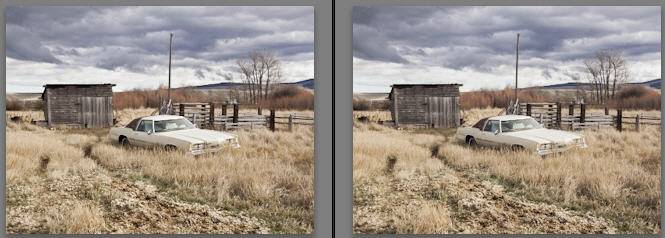
Photo with only modest enhancements in Lightroom 3: Before and After Process Version Update
In this second example, I did very heavy adjustments in Lightroom 3: + 100 on Recovery, +100 on Fill Light, and significant Exposure, Brightness and Contrast as well. The update to the new Process Version, i.e. the translation from old to new isn’t bad, but it nevertheless significantly darkened my photo:
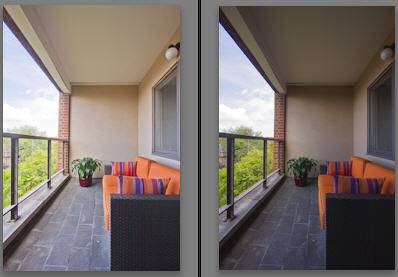
Photo Heavily Worked in Lightroom 3: Before and After Process Version Update
Does this mean that the new Process Version, i.e. the new Lightroom 4, 5, 6 and CC technology and sliders, are bad, and you should never update? Definitely not. The Lightroom 4, 5, 6 and CC controls are more powerful and have fewer unintended side effects. In the second photo above, after updating the process version and then working it with the Lightroom 4, 5, 6 and CC controls, I was able to get more detail in the clouds, more light into the shadows, and avoid odd halos along the tree line caused by using so much Lightroom 3 Recovery. Here is the photo zoomed in on the sky:
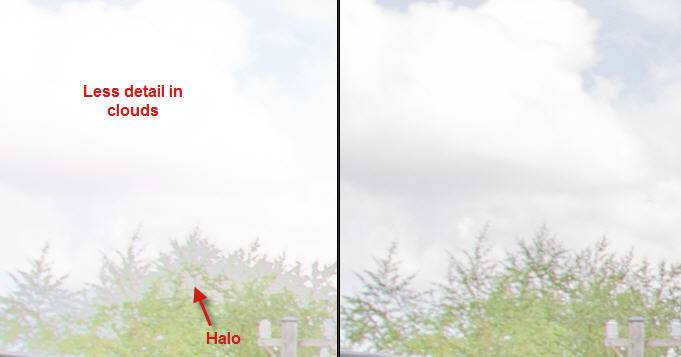
Photo Worked with Lightroom 3 PV Controls; Same Photo Worked with Lightroom 4 2012 PV Controls
What it does mean is that because updating to the new Process Version may significantly change my photo, I am only going to update photos if and when I am willing and ready to rework them.
To update, in the Develop module of Lightroom 4, 5, 6 and CC, simply click on the lightning bolt symbol in the Histogram panel (In Lightroom 4, the exclamation point at the bottom right of your photo.)
You will get the following dialog box:
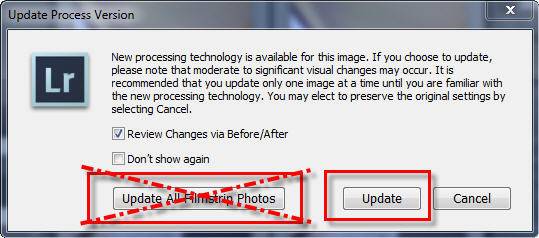
Because of the issues I have discussed, I highly recommend that you do not choose to update all your photos at once — Update All Filmstrip Photos would in fact update all photos you see in your filmstrip at once. Instead, Update will just update the one photo selected.
Review Changes via Before/After will show you the old Process Version right next to the new one. If you choose this option, after you click on Update and review the change, type the shortcut Y to get out of Before/After mode.
If you just updated and want to revert back to Process Version 2010, in the History panel click back to the step before Update Process Version (Temperature in my example below), or use the shortcut type Ctl/Cmd-Z, to undo this last step.
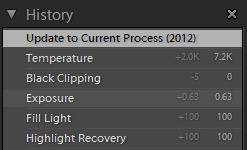
At any time you can change Process Versions in the Camera Calibration panel:

Finally, just remember that until you update to the current Process Version, you will not have access to the new Basic Panel, adjustment brush and graduated filter controls, or the individual Red, Green and Blue channels in the Tone Curve panel point curve. I have gotten many emails from folks asking me why their version of Lightroom 4 or 5 doesn’t have the new controls — now you know!
[scname=”signup”]


A Very very must read article,Very imformative and help full.Even if your not useing lightroom 5 right now,This is great knowledge to know or have in your tool bucket.
Thank you brian
I love the way you look after us Laura
Thanks, Peter – I try! ;-)
Thanks Laura,just in time,I was looking for the update symbol in LR 5 after being used to seeing the exclamation mark in LR 4.Small changes like this can mean a lot of searching around for the answer,I had missed the lightening bolt,no doubt in time I would have found it out but you have saved one old duffer a lot of scratching around!
Ron.
I was so excited to see that you were the first website that came up when I searched google for answers to my LR woes! Thank you for being a LR guru!
Thanks, Kimber – good to see you here!
Thanks you so much! I was confused when I saw the old LR3 panel. Your article helped me sort out this confusion and got me going again.
I was really confused and found no answer @ Adobe. I figured I must have messed something up when I imported my old LR3 catalog, except the problem was the same on both my desktop and laptop. Thanks so much for the clarification. Silly little lightening bolt… I never even noticed it!
Imo, it is silly indeed that Adobe has hidden this feature — the old exclamation point was much more effective!
I have been losing access to the Basic Panel adjustments WB, Exposure, Contrast, Highlights, etc. Is there a VIEW OPTION someplace that I need to check back on? Thanks much
Hi Laurie,
Right-click on the Tone Curve panel name and choose the Basic panel. For some reason it seems to go missing sometimes during Lightroom updates.